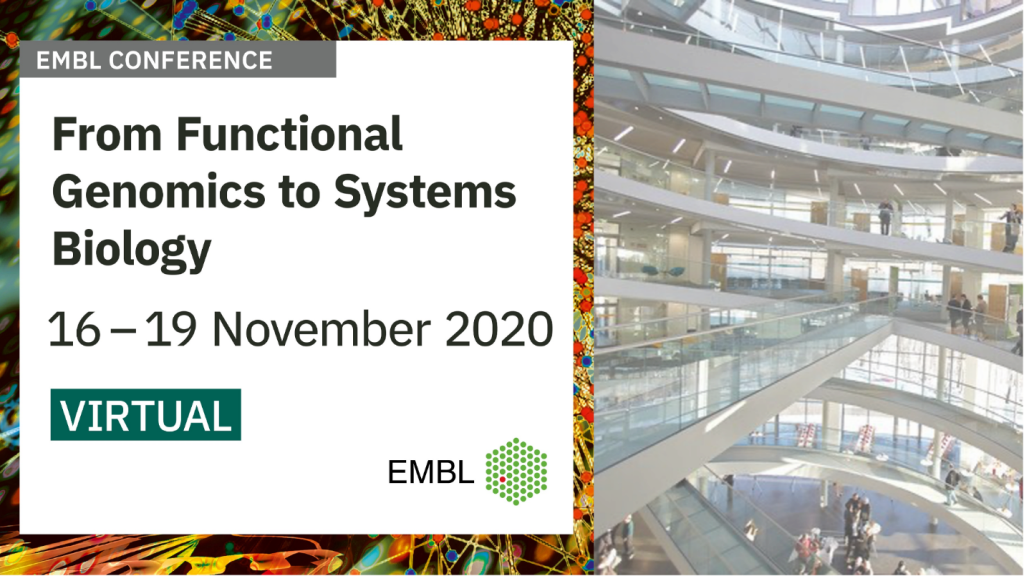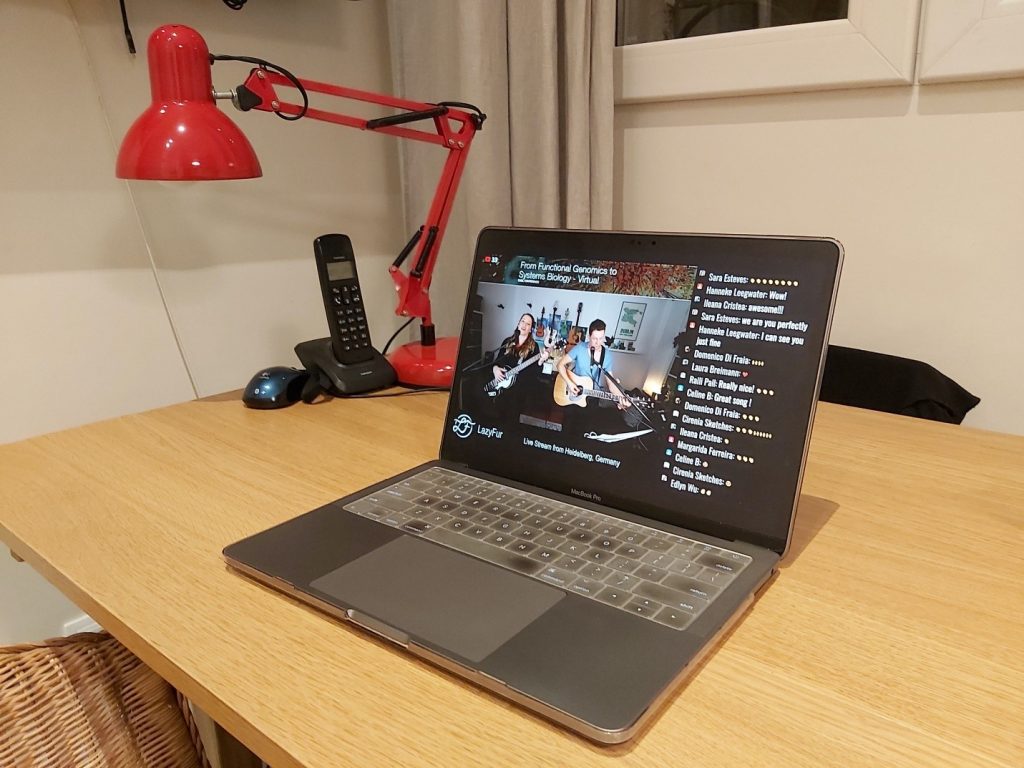‘From Functional Genomics to Systems Biology’ shines virtually
Event report by Jesus Victorino, PhD student at the Universidad Autonoma de Madrid, Spain.
Four Novembers ago, I arrived in Heidelberg on my 24th birthday which I celebrated carrying my first poster as a freshmen PhD student. Back in those days, a hypothesis with an outline of my future experiments was all I captured on that A0 laminated fabric poster. Four years and a PhD later, there could not be a better place to show my results right before defending my thesis than at the very same EMBL conference: From Functional Genomics to Systems Biology. Well, not exactly the same. This time we could not enter the ATC building and walk through its double-helix bridges, since the event took place virtually.

The organising committee managed to set up an online conference, enabling more than 270 participants to share their thoughts and results about genomics, proteomics and imaging. And we got to see everybody’s living room! Although the schedule differed from usual conferences in Europe (13:00-20:00 CET), it broadened the audience by allowing people from other countries to attend. And all that without taking a plane or paying for a hotel room, which significantly decreased the required budget to attend the conference and the carbon footprint we left behind.
I found several additional aspects of attending a virtual conference very exciting. On the one hand, the lack of big crowds in a large room with a single microphone and a line of researchers waiting for their turn, encouraged me to ask questions to the speakers. I simply felt more comfortable. Zoom allowed a record of the many questions asked, and those that were not answered due to time constraints were posted on a Slack channel created to coordinate the meeting. The Slack channel was incredibly helpful not only to increase the feedback with more scientific questions & answers but also to improve networking, especially for the poster session. I hope we keep using a similar virtual space that enables participants to contact other scientists even for onsite conferences.
At least in my experience, the poster session worked out way better than expected, which was a pleasant surprise. I found myself talking with researchers (mainly PhD students) for most of the session, which I never experienced before. I took advantage of the Slack channel to advertise my poster and also to interact with the presenters of other posters I was very interested in. Magically, people were showing up in my Zoom room and I found that breaking the ice virtually was easier than in a real room, since there was no awkward moment in which you hesitate to interact with the presenter, or the presenter does not know whether you might want to know more about his/her research or are just passing by.
On the other hand, I found the platform where we should upload the posters very inconvenient. Instead of uploading our posters in PDF and being able to chat through Slack, Zoom or similar, we had to use ‘iPosterSessions’ and re-shape our posters to fit the virtual and very rigid format of the website. I found the platform non-intuitive and there were incompatibilities, at least with my computer, for the ‘chat’ and ‘contact author’ options within it. Besides, we had to provide a way to virtually meet other participants and present our posters on our own (e.g. a Zoom room or similar), which was not very straight-forward,, and not everyone might have had access to it. Having said that, this was basically the only issue I experienced during the entire meeting – the lectures worked perfectly, we discussed exciting projects and the poster sessions were very fruitful.
Another great choice from the organisers was to schedule ‘meet the speakers’ sessions. I enjoyed meeting three of the speakers together with other early career researchers where we could exchange thoughts and impressions. I think this is very important to train students on how to interact with more senior researchers and I have rarely found a dedicated spot for this at international conferences.
Great kick-off at the #EMBLOmics with a very nice Quantitative genomics session and learning how to identify key TFs at enhancers and promoters with Michiel Vermeulen@EMBLEvents https://t.co/N34eeuSoNJ
— Jesús Mellamo (@JesusMellamoyo1) November 16, 2020
During the conference, all lectures and short talks were divided into four main thematic areas: quantitative genomics, quantitative proteomics, quantitative imaging and single-cell genomics. Here’s my pick from the panel of speakers that I feel represents the essence of each area.
Transcriptional enhancers were the main characters of the quantitative genomics sessions, where different labs addressed the question of how the control of gene regulation affected phenotype in a different way. The fruit fly embryo was one of the preferred model organisms and was used by the team led by Thomas Gregor to study how the spatial organisation of the chromatin affects transcription at the eve locus. Justin Crocker also showed beautiful Drosophila embryos that they used as a test tube to understand the logic of a developmental enhancer and the phenotypic impact of its mutations. With respect to this study of the genotype-to-phenotype impact but in the context of human genome variation, Bart Deplancke told us about how non-coding variants affect gene expression in immune cells unveiling implications in leukemia.
Following with genomics, we witnessed the power of sequencing technology but at the single-cell level to understand physiology and disease. In this thematic area, we learnt with Antonio Lentini about gene expression and silencing at the X chromosome and Dana Pe’er talked about its uses to study development and cancer. The work presented by Henrik Kaessmann was very impressive and stood out not only for the use of thousands and thousands of cells, but for studying spermatogenesis in twelve different mammals providing a valuable resource to study this process across evolution.
The quantitative proteomics sessions taught us about the promising years that we face since improved technology might quickly move the field forward. Bernhard Küster showed how proteomics and in vitro models can be used to investigate drug response to cancer treatments. Although the massive characterisation of the proteome is yet not comparable with the performance of sequencing technologies in the genomic field, Michiel Vermeulen’s talk illustrated how to combine genomics and proteomics to understand cancer biology and identify new important players and therapeutic targets.
The fourth thematic area was quantitative imaging in which Emma Lundberg talked about high-throughput imaging and its use to dissect the human proteome. We could appreciate the potential of the analysis of massive amounts of imaging data in the work presented by Professor Lundberg where they involved hundreds of new proteins in cell cycle and identified new putative roles for proteins they found to localise in multiple subcellular compartments. Super-resolution microscopy could not be missing at this conference and Suliana Manley nicely showed how to use it to study mitochondrial organisation and dynamics.
Outstanding science and fresh data in a very interactive environment summarises the experience at the conference, where I was glad to see that many of the projects presented were shared in the form of preprints. I collected them and included in this list of preprints at the #EMBLOmics for attendees who might want to know more about some of the talks and for those who did not attend and might want to have a flavor of this conference.
I have created a preList @preLights for the virtual #EMBLOmics. It will include all the preprints presented during the meeting so if you have a #preprint let me know to include it!@EMBLEvents
— Jesús Mellamo (@JesusMellamoyo1) November 17, 2020
Of course, it would not have been a proper EMBL meeting without the final gathering and concert. The event ended with a fantastic concert by Lazy Fur which really put the icing on the cake –the concert is recorded here, so you can listen to their nice voices while you prepare for your next experiment. I really thank the organisers for all the effort to make the screen disappear and feel like in a non-virtual event.

Since 2020 has shaken the way we interact with people, scientists, like everyone else, have had to quickly adapt to the new circumstances. In the academic world, conferences play an important role for scientists to share their recent advances and build their contact network. While it was already under debate how to reduce the ecological impact of such a tremendous flow of researchers travelling all over the world, virtual conferences did not seem to launch. All of a sudden, the global pandemic situation has rapidly turned this will to a necessity, leaving us no other option but to evolve. The good thing is that virtual conferences seem to be reasonably meeting our expectations, providing with a more sustainable way of sharing our data and interacting with each other. They offer both advantages and disadvantages with respect to in-person events but undoubtedly have accelerated our steps towards including more virtual conferences in the calendar once we go back to a ‘normal situation’.
About the author
I’m Jesus Victorino, PhD student working in gene regulation and member of the preLights community, a platform to disseminate science and the role of preprints in Biology.